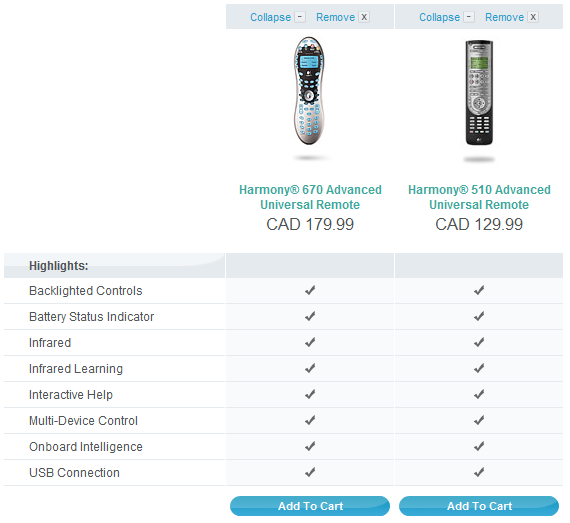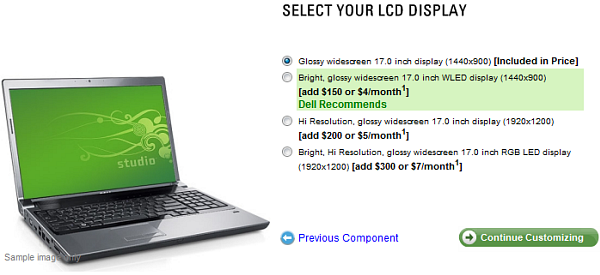 Why Do Big Companies Educate Their Customers So Poorly?
Why Do Big Companies Educate Their Customers So Poorly?

The above is a screen shot taken from Logitech.com, using their online tool for comparing Harmony remotes. This tool is designed to allow potential customers to select the Harmony remote that will work best for them. But why is it then that the two remotes, one nearly double the price of the other (The 510 street price is $99), come up as identical in the comparison tool? Is Logitech really trying to sell a remote for twice as much that doesn't do anything different than the less expensive one? It turns out, no, they're not - but it sure looks that way, doesn't it? I did a bit of research on my own and discovered that the 670 model has PVR-specific controls, while the 510 model does not. This is a pretty important fact for a customer to know, since I'm willing to bet a very high percentage of people buying a Harmony remote own a PVR. So why isn't that listed as a difference between the two products? Logitech is doing a poor job of educating buyers on the differences between their products here, and they're certainly not alone. The online computer-ordering process is among the worst offenders at putting choices in front of the customer and doing a horrible job at explaining what those choices actually mean. 
At CES 2009, I heard someone say that it takes the average consumer two hours to order a computer online from HP.com. Two hours? Imagine what the abandonment rate is on that process! I'm willing to bet orders on Dell.com take just as long. I'm sure there's a significant number of people that would simply get frustrated and give up after the first 30 minutes. Imagine you're an average consumer with a basic knowledge of what you want in a laptop computer, but you're not an expert. Now imagine you're ordering a laptop from Dell, and you come to the step above. On the plus side, Dell actually lists the screen resolution on this model - and most people know that the higher the resolution, the better the display will look. But look closely at those first two options: the second option is identical to the first with the exception of the addition of the word "bright" and "WLED". What on earth does that mean to the average person? It's a $150 upgrade, and Dell offers zero details about why the customer would want one option over the other. Does that mean that the regular glossy widescreen is dull? It's utter nonsense and Dell only confuses consumers with their approach to presenting their products. You'd think Dell would have this down to a science given that the vast majority of their consumer sales are done online. Why don't they have a hyperlink on the word WLED that would trigger a pop-up explaining what that word means, and why a consumer might want it? Elsewhere on Dell's site - in the Studio 15 product configuration tool - Dell busts out entirely fictional words like "900p". On the Studio 15 line, Dell hides the screen resolution from the buyer and instead uses terms such as 720p and 1080p. There's some consumer recognition of those terms, so I can understand why they might use them, but 900p? Why not show the customer the screen resolution in pixels as well? 
HP is better, but only slightly. In the above screenshot, the customer is presented with two screen options. HP helpfully provides the screen resolution, but for $30 more the customer is offered a "BrightView Infinity" screen rather than just a "BrightView" screen. What's the Infinity option you might ask? HP has a "Help Me Decide" link, which is more than Dell offers, but check out what comes up when you click on this link.  Take a look at those big blocks of text to the left. The Infinity option difference is explained a glass that "reaches edge-to-edge" and "gives the appearance of a never-ending display to enhance the total viewing experience". My marketing BS detectors are ringing based on this description - what does that mean exactly? The non-Infinity screen doesn't go edge to edge? What does it do then? If HP had images of these two screens that clearly illustrated the differences between the two screens, it would go a long way to helping the customer decide. Or even real-world descriptions such as "enhanced contrast", etc. Sure, the difference is only $30, and if I were buying it I'd opt for the Infinity option, but if a consumer has a specific budget the lacklustre description does nothing to sway them one way or another. Take a look at those big blocks of text to the left. The Infinity option difference is explained a glass that "reaches edge-to-edge" and "gives the appearance of a never-ending display to enhance the total viewing experience". My marketing BS detectors are ringing based on this description - what does that mean exactly? The non-Infinity screen doesn't go edge to edge? What does it do then? If HP had images of these two screens that clearly illustrated the differences between the two screens, it would go a long way to helping the customer decide. Or even real-world descriptions such as "enhanced contrast", etc. Sure, the difference is only $30, and if I were buying it I'd opt for the Infinity option, but if a consumer has a specific budget the lacklustre description does nothing to sway them one way or another.
I've seen the issue time and time again with friends and family: they're ready to buy a product, and they're presented with an option that they don't understand. More often than not, the confusion that ensues is enough to completely paralyze the purchasing decision. The reason? Fear of making the wrong choice - selecting the wrong option from among choices they don't understand. They usually end up calling me and asking for help - I've configured more computers for friends and family than I can count. I typically ask them what their budget is, what they want to use the computer for, and I configure the best system for their needs. Not everyone has a computer geek they can call up for help though - these companies need to make the process easier. How Big Is That Battery Exactly?Batteries are another one of those issues where the manufacturers do a poor job of educating consumers on the choices they have in the product. Let's take a look at how Dell and HP handle the issue of power on a laptop. 
The image above is from HP, the one below is from Dell. See a difference? HP, to their credit, attempts to show people what the larger batteries look like on a laptop - but it's a generic laptop, not specific to the model the user is buying. Notice that there's a 9-cell battery, yet no image of what the 9-cell battery looks like on it - and there's no option to buy a 12-cell battery, so why show the user the image? Why not show an actual photograph for each laptop model with each battery on it? Yes, it would be added work for the online sales team, but they'd reap the benefits of educating their customers on the differences between the batteries. HP does the right thing when it comes to battery life estimates: that's something that an average consumer can understand, even if it's just an estimate. The word "cell" doesn't mean anything to the average consumer, but a battery life in hours and minutes will click with most people. 
Dell? Dell just phoned it in on their battery picker - Alpha Geeks know that Whr stands for "Watt Hour", but that term means nothing to an average person. Ditto for the cell number - other than "bigger must be better" - and by not putting an estimated battery life on this part of the selection process, or a photo of how much bulk the bigger battery adds, Dell is reducing the customer to a blind guess in terms of which battery is better for them. I've seen numerous comments on YouTube and in forums from people who get a notebook with a bigger battery, and they're shocked when it shows up and it sticks out the back and adds weight to the laptop. Some of these people return the notebook to Dell, so Dell is losing out here. Why not show the customer what the battery looks like on their laptop? Why not tell them what kind of estimated battery life they'll see? I wonder what would happen to their online sales if Dell and HP spent a bit more time making the buying process not only about feeds and speeds, but about customer education? More focused on telling people about what they're buying, and why they might want each feature. I think Dell and HP would see reduced returns, increased sales, and customers that are more satisfied with the product they purchased. And that's worth a little extra work, isn't it? Jason Dunn owns and operates Thoughts Media Inc., a company dedicated to creating the best in online communities. He enjoys photography, mobile devices, blogging, digital media content creation/editing, and pretty much all technology. He lives in Calgary, Alberta, Canada with his lovely wife, and his sometimes obedient dog. He dislikes having to look for real-world photos of how big batteries are on laptops when he's trying to order one. 
Do you enjoy using new hardware, software and accessories, then sharing your experience with others? Then join us on the Thoughts Media Review Team! We're looking for individuals who find it fun to test new gear and give their honest opinions about the experience. It's a volunteer role with some great perks. Interested? Then click here for more information. 
|